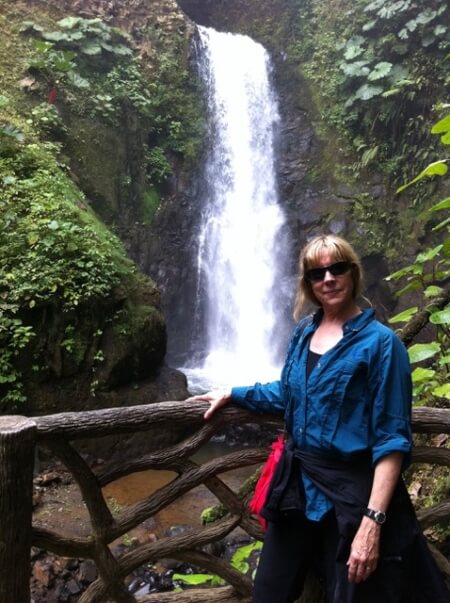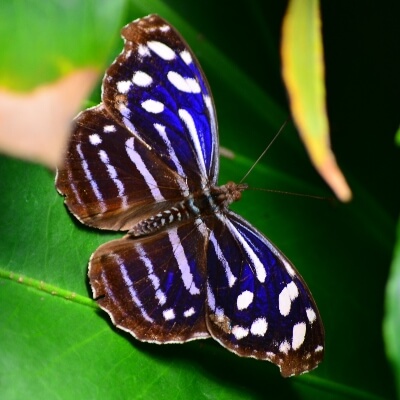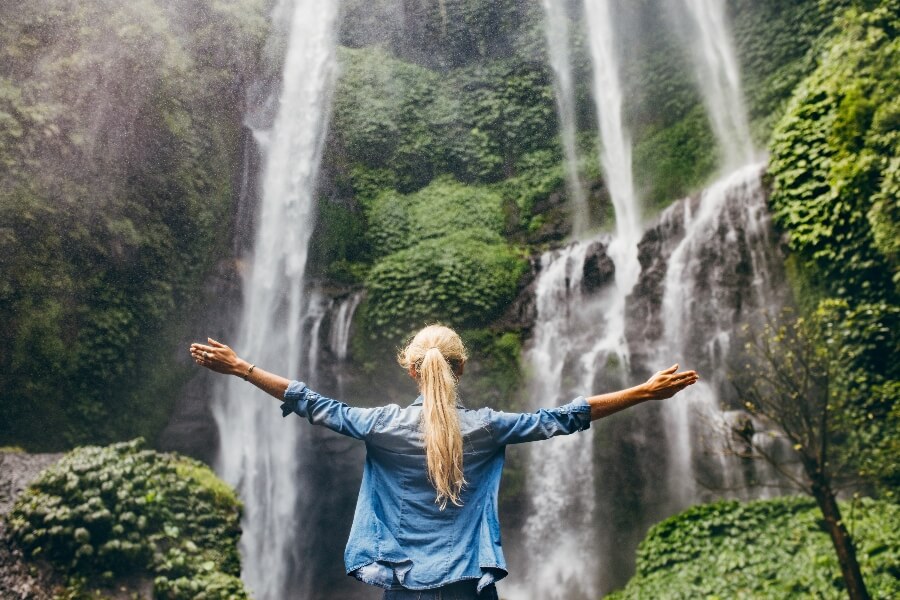Excerpted from Carol Flake Chapman’s book, Wild Surprises: Stories and Poems About Encounters That Shifted My World.
***
Six months after my husband died in Guatemala, I saw an ad for a “healing center” in Costa Rica called Asclepios, named for the god of healing and medicine in ancient Greece. At the time, I was still operating almost completely from the right side of my brain—the side governed by emotion rather than reason—and on impulse, I bought a plane ticket and reserved a room. In my fuzzy, irrational state, I felt that Costa Rica would bring me close—but not too close—to the place where Gary died. I had already begun the journey that I had come to think of as a pilgrimage to deal with my grief, and I envisioned being cocooned in nature at Asclepios, not realizing how apt that image would become.
Two days after I arrived at the center, which was surrounded by green, mist-covered hills ideal for growing coffee and contemplating at dawn, I was still in the state of mind that I think of now as my partial zombie state—putting one foot in front of the other but not really alive. I was a harmless zombie, not seeking to feed on the flesh of the living, but I knew dimly that my eyes had a kind of dazed, unfocused look that must have been disconcerting to the young American women who had come to the center for massages and sunbathing by the pool.
Read More: James Brown and My Great, Humbling Mongolian Adventure
Under the Volcano
Determined to keep in motion, I scheduled a day trip with Pedro Torres, the charming driver who had brought me from the airport in San Jose to the healing center. He had agreed to drive me to Poas Volcano and then to the nearby nature center at La Paz Waterfall. I was looking forward to toucans and butterflies and the sound of falling water.
Losing Gary had made almost all ground I walked on feel unsafe.
“I have to warn you,” said Pedro, as we set out. “The volcano is usually covered in mist. You can’t always see it.” As we wound our way up, I could see evidence of the 2009 earthquake that had killed hundreds in the area around the volcano. The main problem, said Pedro, was the mudslides that had covered roads, sent boulders down mountainsides and smothered people in their homes. “No one could get away,” he said. “And then the roads were gone, so no one could get to them to help them.”
And yet the scars were already disappearing. Green shoots were already springing up from the rubble, rewriting the script of loss on the landscape in a natural resilience I could only marvel at. Pedro said that most of the people who lost their houses and livelihoods had remained near the volcano. “No one wants to leave,” he said. “This is home.”
I had seen that stubborn resistance to giving up on a place time and again when I was growing up on the Gulf Coast. Most people, including my parents, cleaned up debris and repaired roofs after each hurricane, rebuilding their lives as though disaster would never happen again. “It’s only material things,” they would say. “What counts is that we survived.”
In a sense, I supposed, being human has always meant living on the edge, one way or another—on a storm-ridden coast, in an earthquake zone, amid an epidemic, under a volcano, within a violent or besieged culture, near a battlefront or along a tornado alley—but the odds of staying safe seemed to be shifting. Losing Gary had made almost all ground I walked on feel unsafe.
The Fleeing People

We parked in a mostly vacant lot and then walked past a brilliant array of bromeliads lining the path to the volcano. The morning rain had left drops of water on their leaves that shimmered like tiny prisms. The earthquake had destroyed the park around the volcano, but the thirsty plants were already disguising the evidence of upheaval. As Pedro had warned, the mist was so heavy we couldn’t actually see into the crater below, but there was a faint smell of sulfur in the air, and I could hear an ominous bubbling sound, as the volcano made itself known. The devil’s brew, I thought.
I asked Pedro why there was so little evidence of indigenous culture in Costa Rica. He thought for a moment, then shrugged. “We only have about 100,000 indigenous left,” he said. “They’ve all been pushed into little reserves, or they have become no different from other people. They are losing their languages.” That sounded familiar, I said. I mentioned that my Choctaw ancestors had been forced to leave their land and travel the Trail of Tears, losing thousands of their numbers, while those who stayed behind had to hide out in the woods for nearly a century.
Perhaps the devil had decided to be kind, for once.
“Well, I’m half Chorotega,” said Pedro, “but it’s not something I talk about very much. The name Chorotega means ‘the fleeing people.’ We came here from Southern Mexico many centuries ago to keep from being slaves to the Mayan rulers. The Chorotega fought very hard against the Spanish when they invaded. They had the most organized resistance here of all the indigenous people. But of course you know what happened. And now most Chorotega people live in Guanacaste, up in the north.”
“We’ll all be the fleeing people,” I said, “if global warming keeps up.”
“Mother Earth has a fever,” said Pedro, “and she’s going to shake a few of us off.” He suddenly smiled as he spied something glittering that was hidden in a crack on the railing where we had been leaning. It was a little gold heart that someone must have left behind as an offering to the volcano, but Pedro had a different idea. “This is for you,” he said, handing me the heart. “I think the volcano wants you to have it.” So perhaps the devil had decided to be kind, for once. I certainly had nothing worth trading for a heart of gold. My shriveled soul at the moment felt smaller than a grain of salt.
The Blue Waves
We waited in vain for the mist to clear and decided to head for the nature center, located on a flank of the volcano, even as it began to rain. “In a cloud forest, it’s always raining,” said Pedro. As we neared the nature center, the roads got worse. Rain was collecting in ruts and deep puddles in the road. “The epicenter of the earthquake was very close to here,” he said. “They had to rescue hundreds of tourists from the area around the waterfall.”
I wondered what it would feel like to emerge with wings from the prison-like dormancy of an earlier, earth-bound self.
Despite the rutted roads, the La Paz nature center, which had been rebuilt, turned out to be something like a theme park, with an elaborate welcome center and a series of exhibits that included a jaguar in a cage, which made me cringe. But I was eager to see the butterfly observatory, which was regarded as one of the best in the world. As I walked into airy enclosure, I was surrounded by a cloud of fluttering blue morpho butterflies.
Along a display board hung a row of dangling cocoons from which blue wave butterflies were just beginning to emerge. Blue waves resemble the larger and more numerous blue morphos of the region, with the dorsal sides of their upper wings a bright neon blue patterned with white transversal bands and white spots. I watched as a newly emerged blue wave clung to its empty chrysalis and began to try out its wings, moving them tentatively back and forth, as though it were getting used to the idea of becoming airborne after crawling through the world as a worm.
After a few moments, the blue wave fluttered purposefully into the air, aiming toward the flowers and ripe fruit that had been set out as a first feast for the butterflies who now scorned the leaves of the euphorbia plants they had fed on as caterpillars.
A Promise of Change

Metamorphosis, I thought, is always a kind of miracle, though not without pain. As Ovid described it so many centuries ago in his masterwork of mythic stories, metamorphosis is not something that is chosen, but which seems to involve a shape-changing transition that appears drastic, but is somehow inevitable or appropriate — a fearful maiden escaping rape by becoming a tree, men becoming Circe’s pigs that embody their base animal hungers.
A lowly caterpillar must endure a kind of death and dissolution in order to become transformed, to change from little more than a voracious eating tube into a delicate winged creature that drinks nectar through a straw. It’s a mystery of transformation that scientists have only recently begun to solve, using 3D scans that allow them to see inside the chrysalis as the caterpillar dissolves into a kind of primordial genetic soup from the which the butterfly takes shape.
All I knew then was that change was possible.
I wondered what it would feel like to emerge with wings from the prison-like dormancy of an earlier, earth-bound self. It was not an academic question, as I watched the newly hatched butterfly try out its wings. Butterflies have offered us a symbol and a promise that change is possible. I knew that out of Gary’s death and the end of our life together, I would have to find a new life as a new being if I were going to survive. Somehow, I would have to grow wings.
Looking beyond my own bereavement, I wondered if humans were actually capable of transformation. Could we as humans change enough to make a sustainable world—could we transform ourselves from the stage of devouring everything in sight into a different state—one of sipping our resources from a straw and winging our way more lightly into the future?
All I knew then was that change was possible. And that is what I have held on to for dear life, just as the brand-new blue wave butterfly clung to its chrysalis as it spread its wings.
Read More: How Old Do You Feel? Why That’s Such An Important Question as We Age





















0 Comments